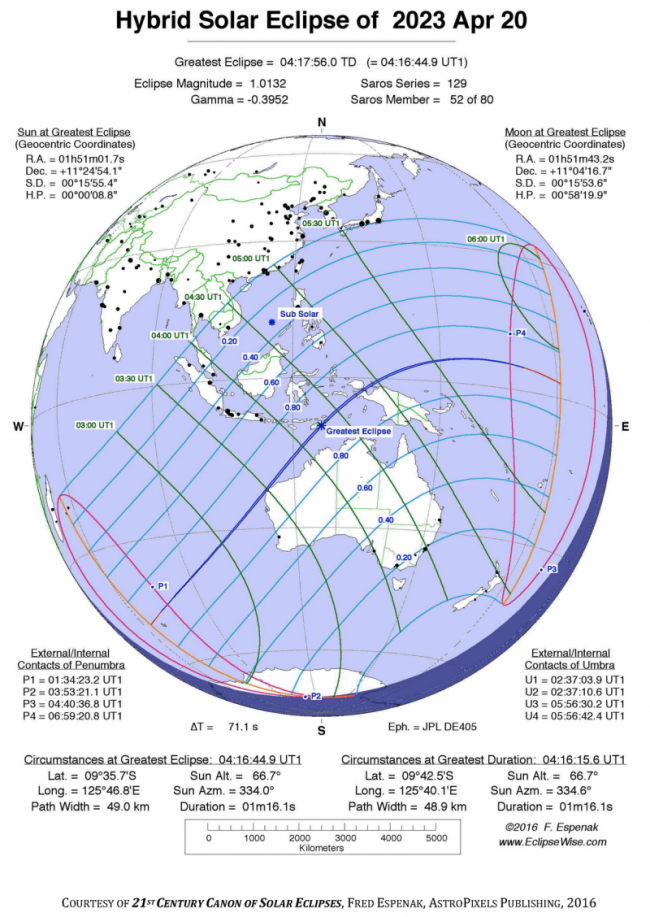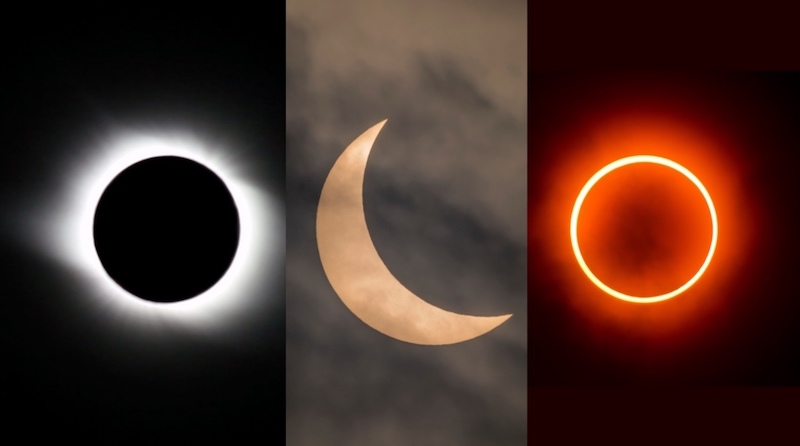
Hybrid solar eclipse April 19-20, 2023
When and where to watch: A hybrid solar eclipse will be visible in Australia, Timor-Leste and Indonesia (West Papua and Papua) on April 20, 2023. At the same time, a partial solar eclipse will be visible on April 20 in southeast Asia, East Indies, Australia, Philippines and New Zealand. The partial eclipse beings at 1:34 UTC and ends at 6:59 UTC on April 20. The central (hybrid) eclipse begins at 2:37 UTC and ends at 5:56 UTC on April 20. Note that, for the Americas, this eclipse takes place mostly on the night of April 19 (so the eclipse isn’t visible in the Americas).
Greatest eclipse takes place off the coast of Timor at 4:16:47 UTC on April 20. There will be 1 minute and 16 seconds of totality.
Duration of the hybrid eclipse is 199 minutes.
Maximum eclipse: At maximum eclipse, the sun is 1.02657 percent covered by the moon with an eclipse magnitude of 1.0132.
Note: In a hybrid solar eclipse, if you are in the path of totality, you see either an annular solar eclipse or a total solar eclipse, depending on your position along the central eclipse path.
The number one rule for solar eclipse observing – even partial eclipses – is to make sure you protect your eyes by using a safe solar filter. Click here to learn how to watch a solar eclipse safely. Purchase eclipse glasses from the EarthSky Store.
The path of the hybrid solar eclipse
An unusual eclipse comes on April 19-20, 2023. Viewers along a narrow path in Australia, Timor-Leste and Indonesia (West Papua and Papua) will see a hybrid solar eclipse on April 20. And along this narrow path the eclipse begins as an annular eclipse, changes to a total eclipse and then becomes an annular eclipse again. At the same time, outside this narrow path, those in southeast Asia, East Indies, Australia, Philippines and New Zealand will see a partial solar eclipse. By the way, hybrid eclipses only occur a few times a century. There will be 224 solar eclipses in the 21st century, and only seven of them will be hybrid eclipses.
On April 20, 2023, the partial solar eclipse will start in the Indian Ocean, coming onshore on the west coast of Australia. Then the path of the eclipse will pass over Australia and Indonesia plus some surrounding regions. Soon the central eclipse (the blue line on the chart below) will start as an annular eclipse along western Australia, Timor and Indonesia. As the eclipse continues along its narrow path, it will become a total eclipse then will turn into an annular eclipse again. Finally, the eclipse will end over the Pacific Ocean as an annular eclipse near the Marshall Islands.
If you are in the areas outside the yellow line (video gif above), you will see a partial solar eclipse. Naturally, the closer to the hybrid path you are, the more the sun will be eclipsed by the moon.
Over the course of 3 hours and 19 minutes, the moon’s central shadow traverses an 8,574-mile-long (13,800-km-long) track covering 0.07% of Earth’s surface area.

Seeing the eclipse from your location
The April 20, 2023, Solar Eclipse Circumstances Calculator is an interactive web page. It can quickly calculate the local circumstances for the eclipse from any geographic location.
You can also find the path of the April 20, 2023, eclipse on an interactive Google map.

This is 2023’s 1st solar eclipse
While this April 20 hybrid solar eclipse is an unusual phenomenon, by far, the most-watched solar eclipse of 2023 will be the October 14 annular solar eclipse, since its path sweeps across very populated parts of the globe in the Americas.
Live music event at the Ningaloo during the eclipse
The band Pink Floyd is celebrating the 50th anniversary of its album The Dark Side of the Moon with a listening event timed to this eclipse, at the UNESCO World Heritage-listed Ningaloo Marine Park (Nyinggulu) in Exmouth, Western Australia. You can watch it on the livestream below or on YouTube.
Bottom line: A hybrid solar eclipse will cross Australia, Timor-Leste and Indonesia on April 20, 2023. Areas in Asia, East Indies, Australia, Philippines and New Zealand will see a partial eclipse. Note that this eclipse takes place on April 19 in the Americas (but the Americas won’t see this eclipse). Find maps and more here.
Read more: What is a hybrid eclipse? A total and annular combined
Read more: Annular-total solar eclipse of April 20, 2023, from Michael Zeller
Big eclipses for North America: Total solar eclipse of April 8, 2024











